As you know, it is getting harder and harder with each day to promote something online, and doing it with Search Engine Optimization will take some time and effort. For that reason, paid search traffic is one of the fastest-growing ways of online paid advertising.
There are plenty of ways you can utilize this tool, from such simple ways as display advertising, social media ads, and Pay-Per-Click advertising.
In this article, we will go over some ways to get started with paid advertisements, how much it costs to create an ad campaign, and the pros and cons of this type of advertising. Of course, those are just some commonalities; you can utilize a significant and excellent world of sponsored ads.
You are welcome to browse our incredible library of articles on PPC advertising, how paid traffic works, and paid traffic vs search engine optimization. So, let’s get started with some paid traffic information without further ado!
What Is Paid Traffic?
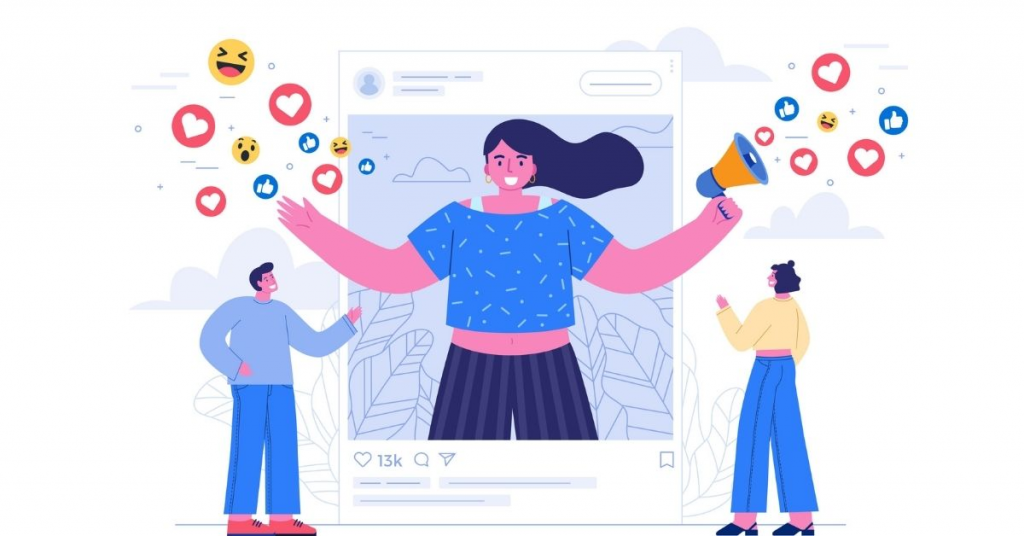
Paid traffic means all the visitors who visit your website through a paid ad. Those can appear in many different places. There are search engine-based ads, social media platforms, and many other ways to promote your posts online. We will go further into the types of paid traffic in the article.
Paid web traffic is also essential when targeting your audience and getting conversions. Regarding return on investment (ROI) factors, it’s one of the most effective ways of promoting your products or services.
You can create paid ad campaigns for any goal; some can be a part of your marketing strategy, boost your presence over the web to gain brand awareness, or bring more people to your social media page. There are plenty of ways you can utilize those tools, and as the world is getting increasingly digital with each second, you can count on those paid ads to bring some results.
Paid Traffic – How It Works?

So, how does it work exactly? Well, it’s pretty simple. You choose a digital platform you would like to utilize to get your ads displayed in front of an audience you have targeted for each paid traffic campaign. Digital advertising is not easy, but with the right approach, you can get your marketing budget worth it with more traffic to your website. Here is how to get started with this concept:
- Define your strategy – you can’t create a marketing campaign without knowing what you are trying to accomplish. Whether we like it or not, generating traffic to your website can get you conversions, additional leads, and even better performance.
- Find your target audience – next, be sure to find out what kind of audience you would like to target. There are plenty of demographics, interests, and whatnot that you can base your campaign on, so be sure to find those potential customers you would like to reach.
- Get the Relevant Keywords – The next thing to do is find relevant keywords for your particular campaign; those would be all the search terms you would like your ads to appear next to. Of course, you can utilize some tools to get better results, like Ahrefs or SEMrush, but you can also research or find the best keywords with Google, for example.
- Find Your Platform – if you want to get website traffic or find some social media presence, you can do that with paid traffic tools. The most popular ones are Google Ads or Facebook Ads, but if you have something more unique, you can try advertising on those specific platforms for your line of business.
- Choose an Ad – find out what type of ad you would like to use for your business; be sure to find something that will suit your needs, whether it’s a search engine-based ad, display ads, or something to put on social media, you can achieve many different goals with it, so be sure to choose carefully.
- Determine Your Budget – be sure to find the proper budget for your ad efforts; there are plenty of ways to optimize your ads’ costs. Especially with PPC ads, you have complete control over how much money you are spending, how much you want to bet on each keyword, or just how much traffic you need to get.
- Create Your Ad – next, be sure to create an ad that will be in line with your needs; make sure that your ad copy has some quality to it, as it can get you a lot more traffic for a lot less money, as the Quality Score does influence the rating of your ads.
- Optimize Your Landing Page – don’t forget to create a landing page that is easy to navigate, easy to use, and has some high-value keywords spread all over it.
- Review and Optimize – and finally – don’t just set up your campaign and let it be. Optimize it accordingly! That way, you will gain control over your social media ads, content marketing, or paid guest posts. Whatever you need, you can get it faster with some additional reviewing!
How Much Does It Cost?
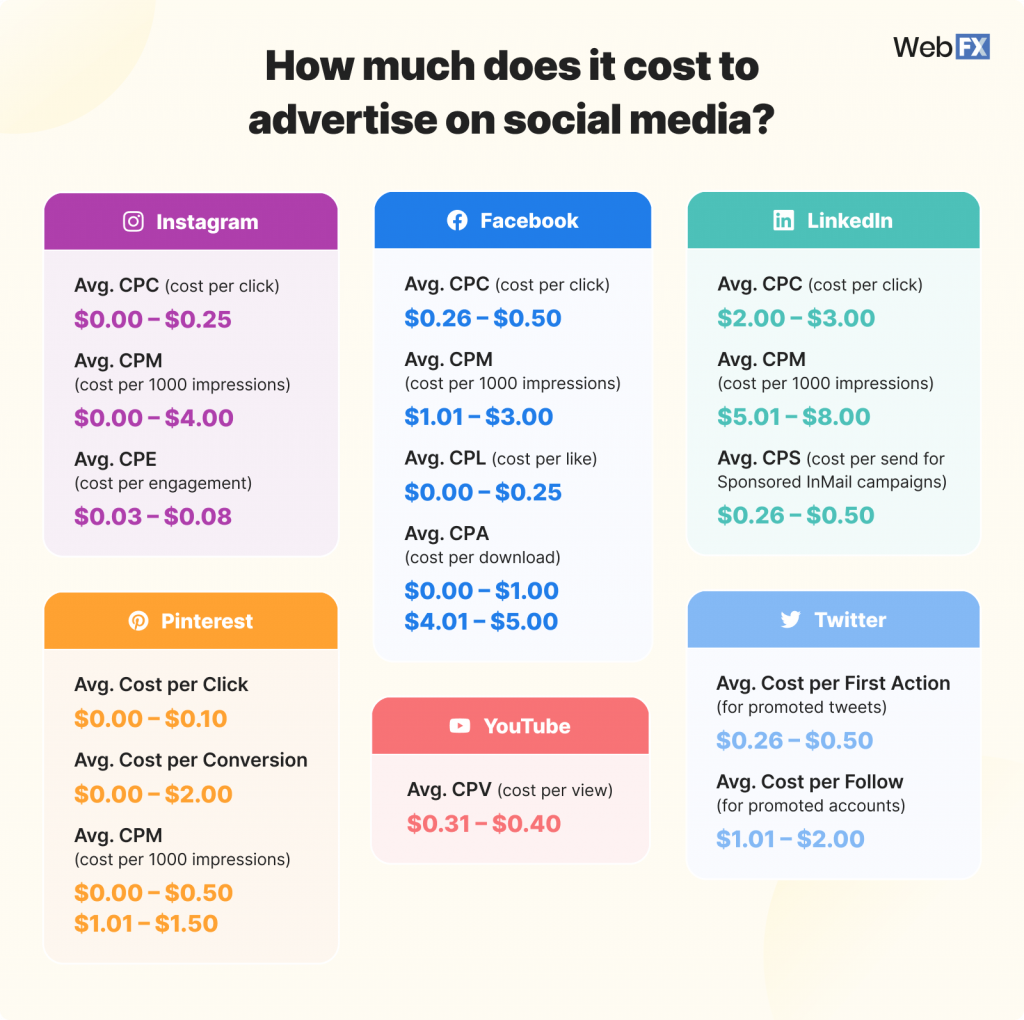
Source: WebFX
So, now that we know what we will be talking about, it’s time to ask the REAL question – how much will it cost? Well, depending on what we try to achieve, it can get from a few dollars to even a couple of thousands. Different keywords will cost more or less depending on their popularity; local PPC will cost differently from some national ads.
There are many things to consider to get the right estimated amount for your campaign. Especially if you are advertising in a specific industry with high-value products, your campaign will skyrocket compared to a simple T-shirt business or something like that.
Additionally, your costs can change during your campaign, with some keywords getting less or more occupied than others, some groups of interest more challenging to get, and even the platform itself can change how much you will pay for ads. Those calculations can change over time, seasons, and even time of day. So, be aware of that.
Here are some of the most commonly known paid traffic payment models.
Cost-Per-Click (CPC)
The first and probably the most popular model is CPC – cost-per-click. As you can probably deduce from the name, you get charged some money every time a user clicks on your ad. The model is pretty simple: the whole budget is divided by the ad’s total number of clicks.
It’s usually used for search ads, like Google or Bing Ads. You can also encounter those in other places, like display and social media advertising. It’s a great model to track your spending and keep a hand on the pulse of your budget. Additionally, as the cost is relevant to the ad’s success, you will only pay if the campaign benefits you. So, it’s excellent for many reasons!
The inner workings of it are also pretty simple. It’s all based on the advanced bidding system. You and other players in the advertising market are bidding against each other for the spot next to the relevant keywords on the search engine results page or social media page.
You can choose your ad placements and whatnot; it depends on the advertising platform. Then, the algorithm puts your ads against the other bidders. Usually, the highest bidder wins, but the Quality Score is also important regarding the ad’s relevance to the search or interest groups or the quality of the landing page.
For example, the higher the Ad Rank in Google, the more likely you are to be shown next to the query or on someone’s wall if you use Facebook Ads.
Cost-Per-Mille (CPM)
Another interesting payment method is the impression model. You usually set the rate for the thousand views you receive. Thus – cost-per-mille. Those are pretty common on social media pages, as the popularity and impressions drive most of the business on those sites.
But you can also get those in places like Google Display Network, where your ads will be shown among many sites within Google’s Affiliate Network.
It’s excellent to also gain some visibility for a reasonable price if you want to grow the brand awareness of your product or service. Or brand, for that matter.
Cost-Per-Action (CPA)
Next, we have the cost-per-action model, which is one of the most expensive out there as you gain money with this payment process. How does it work? Well, you create an ad and determine the outcome that you would like it to achieve. It can be anything, from something as simple as getting signed up for the newsletter to purchasing something on the website.
It’s a model that is great for those looking for high-quality traffic to bring customers in. It’s often used in affiliate marketing and professional stores with highly specialized equipment.
Paid vs. Organic Traffic
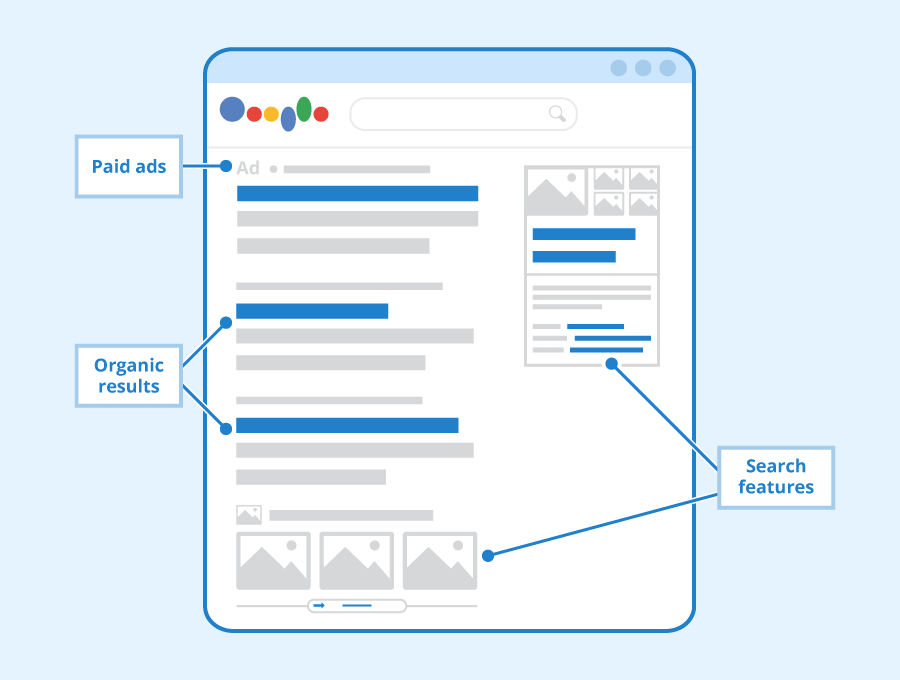
Now, let’s review the most problematic questions: is paid traffic better than organic? Well, our sources tend to believe that it all depends! As usual, we cannot give you a straight answer. In most cases – you should utilize both ends of the spectrum.
The long-term solution of SEO is something that all companies should strive for, but it’s always good to boost some views with a well-drafted PPC campaign.
The same goes for PPC ads. You can utilize this tool, but it’s not like you will always be adding some fuel to the fire that is a PPC campaign and constantly promoting your products with only paid traffic.
You need to diversify your income, as plenty of people could be interested in your products or services, and you can get to them without spending thousands of dollars each month on getting your ads right next to their faces. That is why combining both approaches is essential to maximize your chances of getting the right amount of traffic to your site. With that in mind, let’s review paid traffic’s most important benefits and disadvantages.
Paid Traffic: Pros and Cons
It’s not all bed and roses, but it can be a pretty exciting story. Paid traffic is full of potential, as it grants you access to an incredible amount of people at the moment’s notice. Additionally, you have lots of targeting opportunities, A/B testing options, and many budgeting possibilities.
You can set your ad spend as you like and even get more people interested in your products in the long run. Here are some of the most common pros and cons of paid traffic.
Pros
- Immediate results – the best thing about PPC campaigns and other paid traffic options is that they get the results immediately! Seconds after setting up the campaign, you will see people coming to your site; compared to the long-term solution of content-based marketing or SEO practices, it’s much easier to find people right now with paid traffic opportunities.
- Incredible targeting options – Social media and search engines know a lot about us, and they use that to their advantage. This way, they can create even better ads and target our interests even more precisely! As scary as it may sound, it can also work better for you as an advertiser so that you can target exactly your potential customers!
- Measurability – additionally, paid traffic can be measured easily with advanced tools to present you with the ad performance and the ways to improve it; with Google or Facebook tools, you will get various stats and measurements that you can actually influence with your actions!
- Budgeting – The same goes with budgeting. If something works, it works, and your paid campaigns will continue to improve over time without unnecessary overspending.
Cons
- Cost – the greatest problem with this kind of marketing option is definitely the cost of it all. Those ads can sometimes get pricey, so it can be a solid problem if you would like to promote your products effectively.
- Crowded market – sometimes, it can also get crowded in the market as a whole. There are plenty of people fighting for the same spot, so it can be problematic to win the bidding war.
- Overexposure to ads – additionally, as ads are everywhere these days, you will probably come across a situation where people will stop clicking on sponsored ads because they are often not in line with their search query, and someone just paid for it to be there. Moreover, ads are just too invasive, and people might not respond well to even more advertising.
Types of Paid Traffic Sources
There are plenty of paid traffic sources for your targeted traffic! So, let’s go over some of the most popular ones for you to utilize!
Paid Search Ads

Let’s start with probably the most obvious choice – paid search ads. The most popular one is definitely Google Ads, as it provides you with the largest amount of traffic possible. In most cases, your ads will be shown in the form of a sponsored tag next to a website link. Depending on your Ad rank, it will be shown on top of the search results page or somewhere near the bottom.
Display Network
You can also utilize a display network. In this case as well – Google Display Network is a great example. That way, you will be able to advertise your products on various different sites within the network with videos, images, and other pieces of digital media like banner ads. All websites within the Ad Network will show your ads if a user visits their platform.
Affiliate Marketing
The next example of paid traffic marketing is affiliate marketing. You may have seen it with influencers, as they are often promoting some products with a link to the profile or product and get some amount of money for each click or purchase.
In this day and age – it is still working pretty well, but it seems like the dawn of influencer marketing is setting up on the horizon. What will happen in the future? Well, no one knows exactly. The one thing remains – it will be pretty interesting to watch.
Native Advertising
Next, we have native advertising. It’s one of the most interesting ads, as they are so ingrained within content that they don’t even feel like ads. Those could take the form of sponsored articles and similar ways of advertising.
Most countries have specific laws against this form of advertising without adding a proper disclaimer. Native ads are great when it comes to getting website visitors in a non-confrontational way that some people may find appealing.
YouTube Ads
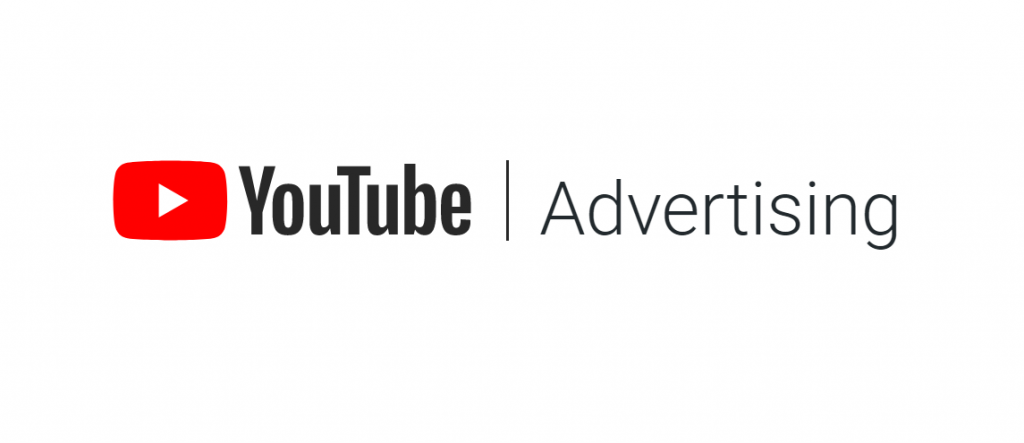
Next, we have the largest video platform in the world that probably needs its own section in our rankings. YouTube is one of the most advanced ad networks in the world, with millions of people logging in every day to watch hours upon hours of videos. There are plenty of ads you can use for this particular platform, with in-stream ads, sponsored cards, and bumper ads.
So, if you want to grow your platform, YouTube advertising is definitely the way to go.
Facebook Ads

Next, we have the famous Facebook ads with dozens of formats and lots and lots of targeting options. It’s one of the best ways to promote your products while also being extremely good when it comes to pricing. Utilize it while you can, as it will get more expensive in the process.
There are plenty of pricing models you can choose from, so if you want to create something particular for your own business – here is where the magic happens.
TikTok Ads

Another great place to start your journey with paid traffic is TikTok ads. With almost 2 billion users from all age groups around the world, it’s a perfect way of promoting your products and services for younger and older audiences.
LinkedIn Ads
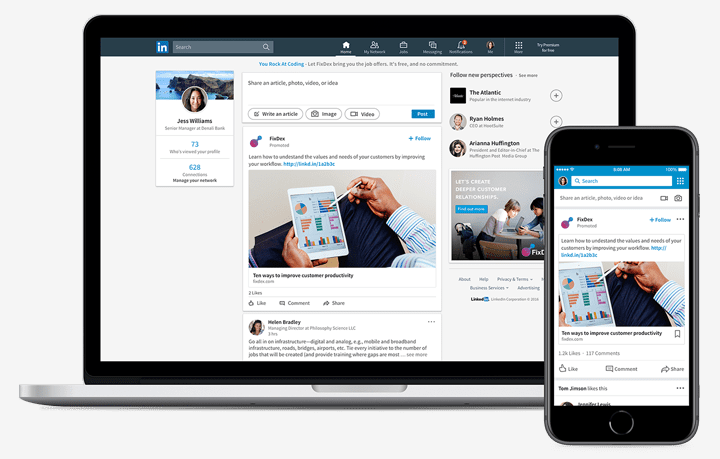
And finally, we have something for the working people – LinkedIn ads. This is the place for the grown-ups, so it’s only fair that B2B brands are common in this place. It’s professional, it has great targeting options and some of the best conversion rates on the market. Definitely worth trying out.
Paid Traffic – Conclusion
In conclusion, paid traffic can be a valuable tool for businesses looking to boost their online presence and reach a broader audience. Whether through pay-per-click advertising, social media promotion, or other methods, paid traffic offers a way to drive targeted visitors to your website. However, it is essential to approach paid traffic strategically, considering factors like budget, audience targeting, and campaign analysis to ensure a positive return on investment. When used effectively, paid traffic can complement organic efforts and contribute to overall digital marketing success.

A PPC specialist who started with organic social media. For several years, the core of his activities are:- Google Ads, Microsoft Ads, Meta Ads, TikTok Ads, Twitter Ads, Linkedin Ads. He has led campaigns with a global reach, e.g. for FootballTeam, G2A, ETOTO, as well as many smaller campaigns in the sports, construction and financial industries. Has full focus on ROAS. Privately, a fan of football, history of wars and Star Wars.

